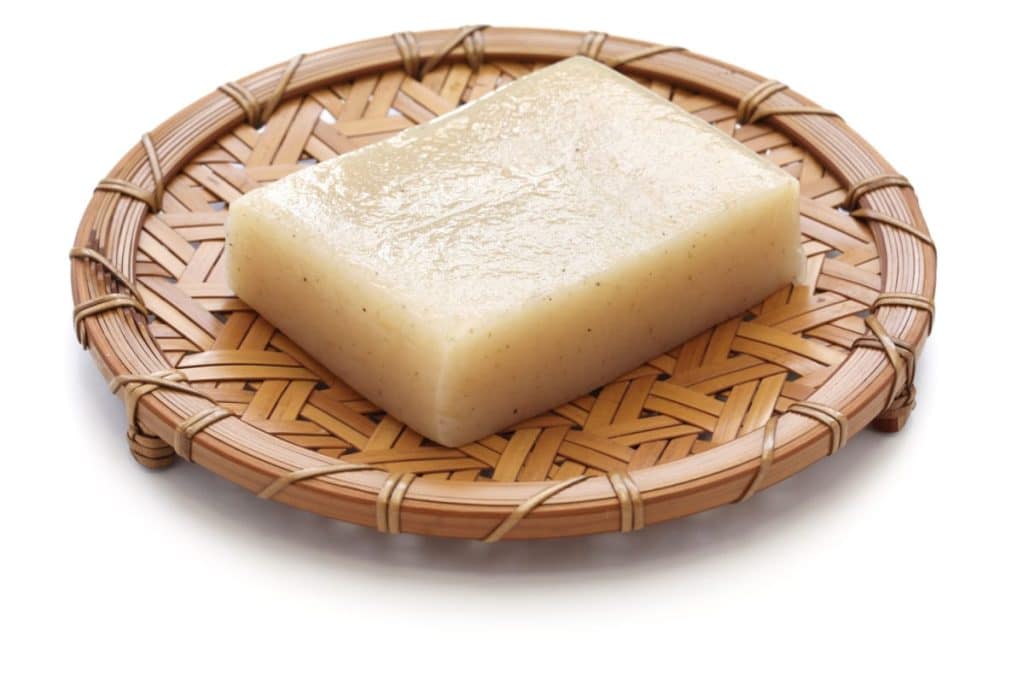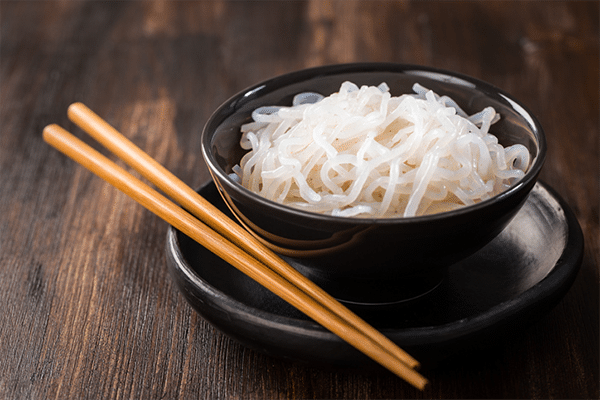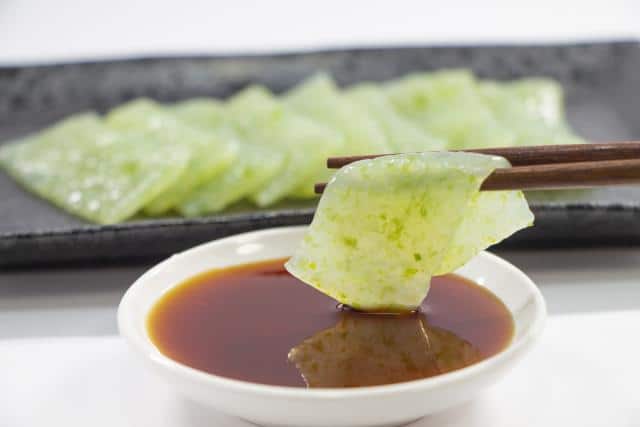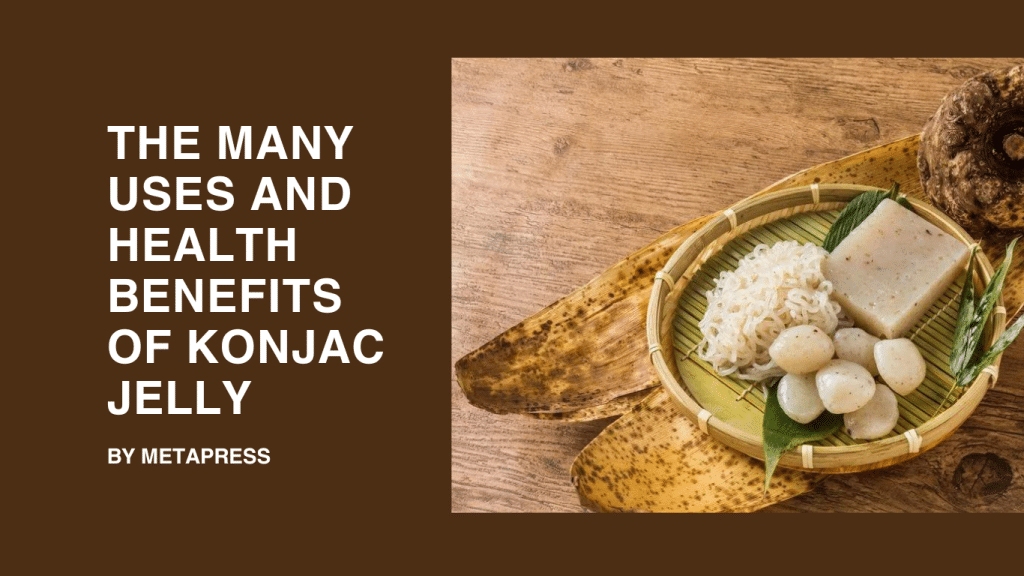What is Konjac Jelly?
Konjac jelly, also known as konnyaku, is a type of food made from the konjac plant. The konjac plant is a root vegetable grown in Asia. It is used to create a jelly-like substance that can be incorporated into various dishes. It is popular in Japan and is known for its unique texture and health benefits.
To make konjac jelly, konjac powder is mixed with water and allowed to solidify. The resulting jelly has a rubbery texture and is typically translucent, although it can be altered with the addition of other ingredients.
What Does It Taste Like?

One of the distinctive characteristics of konjac jelly is its neutral taste. It doesn’t have a strong flavor of its own, which makes it a versatile ingredient that can easily absorb the flavors of other foods.
It is often used as a food additive due to its thickening properties. It can be added to sauces and soups to enhance their consistency without altering the taste. The jelly’s neutral flavor and gel-like texture make it a popular choice for creating a wide range of dishes.
While the jelly itself is tasteless, it can sometimes have a fishy smell. This odor can be off-putting to some people, but it can be eliminated by rinsing the jelly or boiling it in water.
It is important to note that it has a chewy texture and doesn’t dissolve easily in the mouth. Therefore, it is essential to chew it thoroughly to avoid any choking hazards. This aspect should be taken into consideration when serving konjac jelly to young children or the elderly.
The Health Benefits of Konjac Jelly
It offers several health benefits. It is low in calories and high in fiber, making it a suitable choice for those who want to manage their weight. The fiber content in it promotes a feeling of fullness, reducing the urge to overeat. Additionally, the soluble fiber in konjac jelly can help lower cholesterol and regulate blood glucose levels.
The konjac plant itself has various health properties. It contains antioxidants and has antibacterial properties, which can support a healthy immune system. The plant also provides collagen and vitamin C, which are beneficial for maintaining healthy skin.
4 Ways to Enjoy Konjac Jelly
1. Konjac Jelly Juice

There are numerous ways to enjoy it. It can be sliced into blocks and served with diced fruit, providing a refreshing and nutritious snack. Konjac jelly can also be transformed into a drinkable juice by blending it with fruits. The resulting beverage has a thick consistency and can be a healthier alternative to sugary drinks.
2. Konjac Jelly in Oden

In addition to its versatility as a standalone snack or drink, konjac jelly can be incorporated into cooked dishes. It can be stir-fried with sauces, adding a unique texture to the dish. It is commonly used in Japanese cuisine, particularly in dishes like oden, a winter festival food that consists of various ingredients simmered together in a flavorful broth.
3. Itokonnyaku

Another popular way to enjoy it is by using it as a substitute for noodles. Shirataki noodles, also known as itokonnyaku, are made from konjac jelly. These translucent noodles are extremely low in calories and can be prepared in a variety of ways, making them a great option for those on a weight loss journey or following a low-calorie diet.
4. Sashimi

For those seeking a vegan alternative to traditional sashimi, konjac jelly can be sliced and flavored with citrus to create a refreshing and satisfying dish. The jelly’s chewy texture provides a unique experience similar to sashimi, but with a plant-based twist.
Conclusion
It is a versatile and healthy food option. It is made from the konjac plant and is known for its rubbery texture and neutral taste. It can be used as a food additive, thickening sauces and soups, or enjoyed as a standalone snack or drink.
It offers several health benefits, including being low in calories, high in fiber, and supporting a healthy immune system. With its various culinary applications, konjac jelly is a popular choice in Japanese cuisine and is worth exploring for its unique texture and versatility.
FAQ about Konjac Jelly
Is Konjac Jelly healthy?
Yes, it is considered to be quite healthy. It is rich in dietary fiber and low in calories, making it a popular choice for people on weight-loss or low-calorie diets. It can also help to promote a feeling of fullness, which can be beneficial for appetite control. However, like any food, it should be consumed in moderation as part of a balanced diet.
What does it taste like?
Pure Konjac Jelly is essentially tasteless, but it absorbs flavors well and is often used in dishes or desserts with strong flavors. In many commercial products, it’s often flavored with fruit juices or sweeteners.
Can I eat Konjac Jelly if I’m a vegetarian or vegan?
Yes, it is plant-based and does not contain any animal products, making it suitable for both vegetarians and vegans.
How is Konjac Jelly used in cooking?
It is quite versatile and can be used in a variety of dishes. In Asian cuisines, it’s often used in soups, stir-fries, hot pots, and noodle dishes. It’s also used to make vegan gelatin desserts, as a thickener in sauces, and as a main ingredient in low-calorie desserts like jelly drinks.
Can I make it at home?
Yes, making Konjac Jelly at home is possible if you can source konjac flour or powder. The process involves mixing konjac flour with water and a bit of lime water, then boiling the mixture until it forms a gelatinous consistency.
Does it have any side effects?
While Konjac Jelly is generally considered safe for most people, it can cause some digestive side effects in some individuals, such as bloating, diarrhea, or stomach cramps, particularly when consumed in large quantities. Additionally, due to its high fiber content, it’s important to consume plenty of water alongside it to prevent digestive discomfort.
Is it suitable for people with diabetes?
Yes, it can be a good choice for people with diabetes as it is low in carbohydrates and calories. However, it’s important to be mindful of any added sugars or flavorings in commercially produced Konjac Jelly products, as these can impact blood sugar levels. As always, if you have diabetes or any other health condition, it’s best to consult with a healthcare professional before making any major changes to your diet.
Are there any allergies or intolerances associated with Konjac Jelly?
While allergies to Konjac are not common, some people may have a sensitivity or allergy to it. Symptoms could include itching, rashes, swelling, or difficulty breathing. If you experience any of these symptoms after consuming it it’s best to seek medical advice.
Can it be used in weight loss?
Yes, Konjac Jelly can be used as part of a weight loss diet. It is low in calories and high in fiber, which can help to promote feelings of fullness and reduce overall calorie intake. However, it should not be relied upon as a sole source of nutrition and should be part of a balanced diet combined with regular exercise.
Can children eat Konjac Jelly?
Yes, children can eat it. However, due to its jelly-like consistency, it can be a choking hazard, especially for younger children. It’s important to supervise children while they’re eating it and to serve it in small pieces.
How long does it last?
Unopened, commercially preparedKonjac Jelly can last for several months when stored in a cool, dry place. Once opened, it should be refrigerated and consumed within a week. Homemade Konjac Jelly should be consumed within a few days and kept refrigerated.
